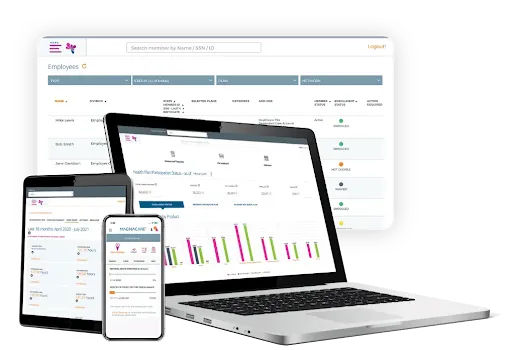Self funded health plans are gaining momentum as employers look for greater flexibility and control over their benefits. By financing employee healthcare claims directly, organizations can achieve cost savings and design benefits that fit their workforce. But this model also creates a core challenge: how to keep costs in check while ensuring positive member outcomes.
For many employers, the problem lies in relying on indicators like end-of-year claims reports. Without timely insights, it’s nearly impossible to anticipate risks or make proactive decisions. That’s where technology comes in. By turning raw data into real-time intelligence, modern tools help employers shift from reactive cost management to a more strategic, forward-looking approach.
In this article, we’ll explore the challenges of managing self funded plans without flexible technology, how modern platforms turn data into actionable insights, and the benefits employers can achieve by embracing a data-driven approach to their health plans.
The Challenges of Self Funded Plans Without the Right Technology
Managing a self funded health plan without the right technology leaves employers at a disadvantage. While self funded plans offer flexibility and potential savings, those that lack timely and detailed data face significant obstacles.
Limited Visibility
Employers often struggle to see where dollars are being spent. Without access to real-time utilization data, it’s difficult to understand which services, providers or member groups are driving the highest costs. This lack of transparency makes it nearly impossible to spot inefficiencies or intervene early.
Inability to Benchmark
Another challenge is the inability to compare performance against industry norms or the performance of peer organizations. Without clear benchmarks, employers can’t easily gauge whether their spending is above or below average, or whether members are receiving appropriate levels of care.
Reactive Management
Perhaps the most pressing issue is that decision-making becomes reactive. Employers are left to address costs only after they’ve occurred, rather than identifying risks or trends in advance. This cycle undermines both cost control and member health outcomes, leaving organizations feeling like they are always one step behind.
These challenges highlight why technology has become so central to the success of self funded health plans. Employers don’t just need data, they need tools that transform data into insights they can use.
How Technology Transforms Data into Insights
Technology is reshaping how self funded employers manage their health plans. Instead of waiting for year-end reports or piecing together information from multiple sources, the best technology platforms integrate claims, enrollment and utilization data into one place. This approach turns data from something static into something dynamic, an everyday tool for better decision-making.
From Raw Numbers to Actionable Insights
Spreadsheets of claims data can be overwhelming, but when presented through modern reporting tools and dashboards, that same information becomes much more useful. Employers can quickly see which services drive the bulk of costs, how members are using their benefits, and where potential inefficiencies lie.
Faster, More Strategic Decisions
By pulling all this information together, employers can make decisions with far greater confidence. Instead of reacting after costs have already spiked, they can benchmark spending, identify problem areas and take steps to improve outcomes. In short, technology gives employers the visibility they need to manage costs proactively, not reactively.
Benefits for Employers
When flexible technology is applied to self funded health plans, the advantages go beyond administrative convenience. Employers gain the ability to see the full picture of how their plan operates — and more importantly, to act on it. The result is better cost control, stronger decision-making and healthier outcomes for members.
Cost Control and Transparency
One of the biggest benefits is visibility into spending. With integrated claims and utilization data, employers can:
- Identify top cost drivers in real time, whether that’s high-volume services, specific providers or particular member groups.
- Compare costs across different care settings. For example, spotting when members are using the ER for issues that could be better addressed in an urgent care clinic.
- Track spending over time to see whether interventions or plan design changes are working.
This level of transparency gives organizations the ability to anticipate problems rather than simply paying the bill when it arrives.
Better Decision-Making
Access to clean, reliable data also strengthens the decision-making process. Employers can:
- Benchmark against industry norms to see whether their plan is performing as expected.
- Use reporting and analytics to model the potential impact of plan design changes, such as adjusting copays or expanding preventive care coverage.
- Replace guesswork with evidence-based decisions, leading to more sustainable long-term strategies.
Improved Member Outcomes
Perhaps the most important benefit is what better data can do for members themselves. Technology gives employers and administrators the ability to:
- Spot trends that indicate a member may need additional support, enabling early intervention.
- Target case management or wellness programs where they will have the most impact.
- Empower members with accessible mobile apps that make it easier to understand their coverage and make smarter healthcare choices.
The net effect is a plan that not only manages costs but also supports healthier, more engaged employees.
Technology in Practice
Technology’s real value shows up in the day-to-day health plan decisions employers make. A CFO doesn’t need every line of claims data — they need a clear snapshot of where costs are trending. A benefit administrator wants to know if members are struggling with out-of-pocket expenses. Modern platforms bring these perspectives together in real time, turning a flood of data into accessible, role-specific insights.
BHPS’ Create® Technology is one example of how this works in practice. By combining claims, enrollment and member data it gives employers a clearer line of sight into their plan performance and the tools to respond strategically.

From Reactive to Proactive Management
For years, health plan sponsors would receive claims data months after the fact, then scramble to make adjustments based on costs that had already been incurred. That reactive cycle left little room for prevention, innovation, or long-term strategy.
Today, technology makes it possible to break out of that cycle. By putting real-time insights at the center of decision-making, employers can anticipate trends, identify risks earlier and design smarter benefit strategies. The shift from reactive to proactive management doesn’t just improve cost control, it also leads to healthier and more engaged members.
Self funded plans no longer need to operate in the dark. With the right tools, employers can take a more confident, forward-looking approach that benefits both their bottom line and their workforce.
If you’re ready to see how the right technology can bring this level of visibility and control to your organization, contact us today to learn more about our health plan management services.

